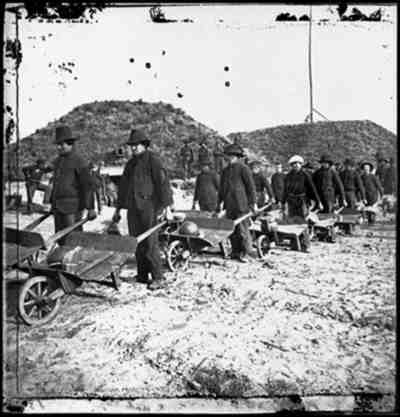

In sharp contrast to the strategic failure of the brick Fort Pulaski is the
success of Fort McAllister, a Confederate earthwork
fort on the bank of the Ogeechee River, which survived every attack from the
sea. Fort McAllister defended the "back door" to Savannah for blockade
runners. Built by Capt. John McCrady, the engineer who designed the defenses
of Savannah, the fort survived seven attacks by Federal naval vessels, including
ironclads, attempting to reduce the fort with the largest shells fired by a
naval vessel in the Civil War. On Jan. 27, 1863, the Montauk, the second
monitor-class ironclad constructed, led a five-ship armada up the Ogeechee to
within 1,500 yards of the fort, and opened up its artillery. Captain John Warden,
who had captained the original Monitor against the C.S.S. Virginia
(or Merrimack) in the classic battle at Hampton Roads, Virginia, hurled
61, 15-inch shells at the fort over five hours. That night, the Confederates
snuck out of their bomb proofs and filled the craters in with sand, making the
fort as good as new. Frustrated, the Federals returned several other times,
only to be disappointed with the results of their bombardment. Fort Mc-Allister
was to fall, however, to Gen. W.T. Sherman's
men, who stormed the fort from the mainland on Dec. 13, 1864. Sherman, frustrated
at the defenses of Savannah, was desperate to open up a supply line from the
Ogeechee River to his hungry troops, but Fort McAllister was protecting the
entrance to the river. The fort's big guns were trained on the river, and it
was garrisoned by little more than 200 men. The Union had approximately 4,000
troops, which simply overran the fort's defenses and fought the Confederates
hand-to-hand. "The fort was never surrendered, it was captured by overwhelming
numbers," reported C.S. Maj. George W. Anderson, who was in command of
the fort. When C.S. Capt.  Nicholas
Clinch was called on to surrender during the assault, he responded with a blow
from his sword, and hand-to-hand combat ensued, with Clinch going down only
after three saber, six bayonet, and two gunshot wounds. Capture of this fort
sealed the doom of Savannah, which was evacuated Dec. 19-20, 1864. Considered
to be the best preserved earthwork fortification of the Confederacy, today the
fort is a 1,700-acre state park thanks to preservation
efforts by automobile industrialist Henry Ford, who had timber interests here
and a home in Richmond Hill. A museum is located at
the site, which has books and a video related to the history of the area. Beside
the parking area are large pieces of machinery salvaged
from the wreck of the Nashville (or Rattlesnake), a Confederate
blockade runner which was sunk by the Montauk. A living history event,
The Civil War Soldier, is held yearly on Labor Day
weekend.
Nicholas
Clinch was called on to surrender during the assault, he responded with a blow
from his sword, and hand-to-hand combat ensued, with Clinch going down only
after three saber, six bayonet, and two gunshot wounds. Capture of this fort
sealed the doom of Savannah, which was evacuated Dec. 19-20, 1864. Considered
to be the best preserved earthwork fortification of the Confederacy, today the
fort is a 1,700-acre state park thanks to preservation
efforts by automobile industrialist Henry Ford, who had timber interests here
and a home in Richmond Hill. A museum is located at
the site, which has books and a video related to the history of the area. Beside
the parking area are large pieces of machinery salvaged
from the wreck of the Nashville (or Rattlesnake), a Confederate
blockade runner which was sunk by the Montauk. A living history event,
The Civil War Soldier, is held yearly on Labor Day
weekend.
Read and add comments about this page